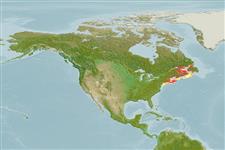Teleostei (teleosts) >
Gadiformes (Cods) >
Gadidae (Cods and haddocks)
Etymology: Microgadus: Greek, mikros = samll + Latin, gadus = a fish, cod? (Ref. 45335); tomcod: Not available. See CoF (Eschmeyer, April 2006, Ref. 56787)..
More on author: Walbaum.
Environment: milieu / climate zone / depth range / distribution range
Ecology
Marine; freshwater; brackish; demersal; anadromous (Ref. 26213); depth range 0 - 69 m (Ref. 57178). Temperate; 54°N - 36°N, 76°W - 56°W (Ref. 86798)
Northwest Atlantic: southern Labrador in Canada to Virginia in USA.
Size / Weight / Age
Maturity: Lm ? range ? - ? cm
Max length : 38.1 cm TL male/unsexed; (Ref. 5951)
Dorsal spines (total): 0; Anal spines: 0. Body elongated; head small; eyes relatively small. Pelvic fins with a slightly elongated filament. Olive green brown or yellow dorsally, paler ventrally; with dark mottling on sides and fins.
Found in coastal, brackish and fresh water, landlocked in several lakes. Feeds mostly on small crustaceans, (especially shrimps and amphipods); also worms, small mollusks, squids and fishes (smelt, sticklebacks, striped bass, alewives, shed, herring and sculpins (Ref. 5951)) (Ref. 1371).
Life cycle and mating behavior
Maturities | Reproduction | Spawnings | Egg(s) | Fecundities | Larvae
Oviparous, sexes are separate (Ref. 205).
Cohen, D.M., T. Inada, T. Iwamoto and N. Scialabba, 1990. FAO species catalogue. Vol. 10. Gadiform fishes of the world (Order Gadiformes). An annotated and illustrated catalogue of cods, hakes, grenadiers and other gadiform fishes known to date. FAO Fish. Synop. 125(10). Rome: FAO. 442 p. (Ref. 1371)
IUCN Red List Status (Ref. 130435)
Threat to humans
Harmless
Human uses
Fisheries: minor commercial; gamefish: yes
Tools
Fatal error: Uncaught mysqli_sql_exception: Too many connections in /var/www/html/includes/speciessummary.lib.php:2104
Stack trace:
#0 /var/www/html/includes/speciessummary.lib.php(2104): mysqli->__construct()
#1 /var/www/html/summary/speciessummary.php(1787): checkRecordDisplayFBQuizV2()
#2 {main}
thrown in /var/www/html/includes/speciessummary.lib.php on line 2104
